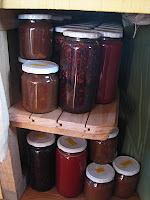The Art of Canning

Canning seasonal fruits and vegetables for winter storage and enjoyment was once as common a household chore as buying groceries. And I am not referring to some ancient past: in my generation canning has transformed from fuzzy childhood memory to an old-fashioned, grueling task that is considered unnecessary and time-consuming in the modern-age of stocked supermarket shelves filled with year-round produce. So naturally I wanted to challenge this social construct and to try canning for myself.
I examined our food consumption patterns and decided the one item we use a lot of, but which could readily be made and stored is tomato sauce. The tomato sauce commonly sold in supermarkets here in Chile comes in little plastic baggies and is of horrendous quality; once confirmed for me in a conversation with a friend who worked for a time as an inspection supervisor in a large tomato sauce factory, quoting for me the regulated allowances for rat parts and molds in the massive sauce vats. In re-reading Barbara Kingsolver’s excellent book Animal, Vegetable, Miracle, I found a recipe shared by her daughter Camille for a delicious tomato sauce specifically written for canning on a large, but manageable, family-scale.
Our personal tomato harvest this year was slim with the excess rain and lack of summer sun (we are ironically experiencing more sun now in Autumn than all of Summer) and the majority of our tomatoes had to be picked green, reddening slowly indoors in storage. Bu the farmers’ market was bursting with tomatoes from better-strategically placed greenhouses in our region, and we easily brought home a crate of 20 home-grown, delicious kilos for under $6 USD. I saw no reason to forgo canning simply because our garden did not produce the fruit. I really wanted to practice this not-so-forgotten food storage art and supporting local farmers at the same time was an added bonus.
Now came the actual work of converting these ripe tomatoes into sauce and then safely sealing the many steaming liters in sterilized jars, and I’ll admit, I got discouraged before we even began. It seemed overwhelming all the pots of boiling water, and tomatoes just happen to be one of those fruits that I dislike chopping for their slipperiness. Directions in one book called for a canning rack, others for thermometers and time schedules, to peel or not to peel… I despaired. This is why the supermarkets have us, I thought. But then Christine just began dousing tomatoes in boiling water one by one and I set up chopping their skinless selves into a growing pot of sauce. Just quietly by candlelight on the wood-burning stove the overwhelming task fell into an assembly and before we knew it we were stirring in the last ingredients to a thickening vat of sauce. John Seymour, the author of our informal house bible, The Self-Sufficient Life and How to Live It, recommended placing folded dishtowels on the bottom of the pot used to bathe the filled jars for the final canning process in lieu of a fancy canning rack and this simple substitute worked fine. Once pulled from their bath and set on the counter to cool, all our jar lids sealed properly.
So naturally, so quietly, so inexpensively delicious. Why would this art have ever been overlooked, pushed aside, discarded, forgotten? That is as confusing a question to answer as why we must drive distances we can easily walk, or why we so readily employ strangers to raise our children, or why we trust faceless, mega-corporations to provide us with nutritional meals. It just happens. We are a funny animal, and maybe made funnier still by re-examining ourselves, our actions, our values, and willingly admitting that we made a mistake; like mass-producing the plastic bag, factory-scale tomato sauce was a decadent error in our 20th century development that only led to excess consumer waste for a bad-tasting product. Hopefully canning will come back into fashion. Here in Los Brujos it has been all the rage this season: canning blackberry jam, murta-berry jam, rose hip jam, apple sauce, and of course the Kingsolver tomato sauce. Long may the art of canning and other seasonal food storage grace the kitchens and pantries of people the world-over. We have only to gain nutritional and taste quality, not to mention the warm company of working in groups of family and friends to prepare delicious meals. Candlelight atmosphere optional.

